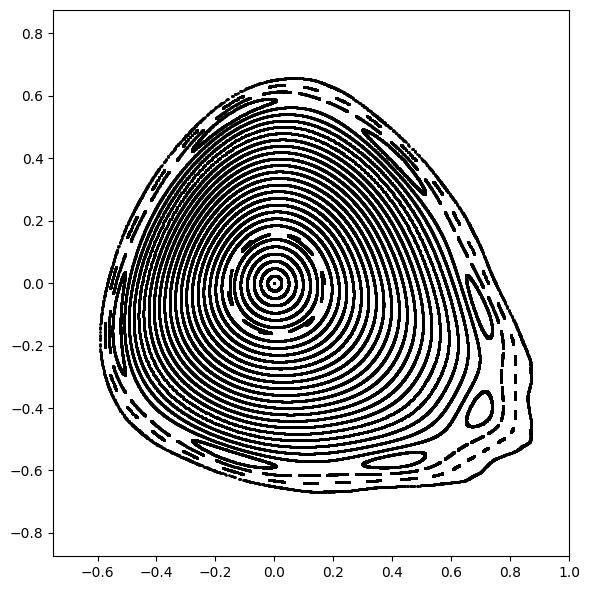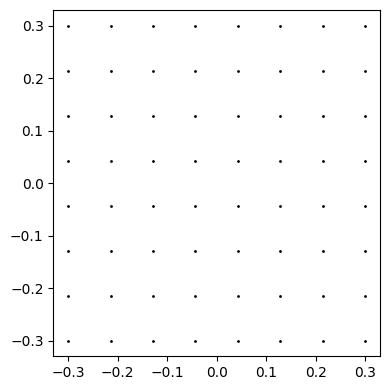Example-57: Trajectory (Approximate invariants spread)
[1]:
# In this example derivatives of approximate invariants spread with respect to parameters are computed
# Given a set of initial conditions, an objective function can be constructed
[2]:
# Import
import torch
from matplotlib import pyplot as plt
from model.library.custom import Custom
from model.library.line import Line
from model.command.mapping import mapping
from model.command.trajectory import trajectory
[3]:
# Define 4D symplectic transformation
nux, nuy = torch.tensor([0.168, 0.201], dtype=torch.float64)
mux, muy = 2*torch.pi*nux, 2*torch.pi*nuy
cx, sx, cy, sy = mux.cos(), mux.sin(), muy.cos(), muy.sin()
def transformation(x, k, dp=None):
qx, px, qy, py, *_ = x
return torch.stack([
cx*qx + sx*(px + qx**2 - qy**2 + k*(qx**3 - 3*qx*qy**2)),
cx*(px + qx**2 - qy**2 + k*(qx**3 - 3*qx*qy**2)) - sx*qx,
cy*qy + sy*(py - 2*qx*qy + k*(-3*qx**2*qy + qy**3)),
cy*(py - 2*qx*qy + k*(-3*qx**2*qy + qy**3)) - sy*qy
])
k = torch.tensor(0.0, dtype=torch.float64)
x = torch.tensor([0.0, 0.0, 0.0, 0.0], dtype=torch.float64)
print(x)
print(transformation(x, k))
tensor([0., 0., 0., 0.], dtype=torch.float64)
tensor([0., 0., 0., 0.], dtype=torch.float64)
[4]:
# Define custom element using the above transformation
custom = Custom('custom', transformation, ['k'])
print(custom(x))
tensor([0., 0., 0., 0.], dtype=torch.float64)
[5]:
# Define line with a single custom element
ring = Line('ring', [custom])
print(ring(x))
tensor([0., 0., 0., 0.], dtype=torch.float64)
[6]:
# Test tracking
k = torch.tensor(0, dtype=torch.float64)
x = torch.tensor([0.001, -0.0001, -0.005, 0.0001], dtype=torch.float64)
data = custom.data()
data['k'] = k
print(transformation(x, k) - custom(x, data=data))
data = ring.data()
data['custom']['k'] = k
print(transformation(x, k) - ring(x, data=data))
tensor([0., 0., 0., 0.], dtype=torch.float64)
tensor([0., 0., 0., 0.], dtype=torch.float64)
[7]:
# Test wrapper
fn, *_ = mapping(ring, 0, 0, ('k', ['Custom'], None, None))
print(transformation(x, k) - fn(x, k.unsqueeze(-1)))
tensor([0., 0., 0., 0.], dtype=torch.float64)
[8]:
# Test derivatives
k = torch.tensor([0.0], dtype=torch.float64)
x = torch.tensor([0.0, 0.0, 0.0, 0.0], dtype=torch.float64)
print(torch.func.jacrev(transformation)(x, k.squeeze()))
print()
print(torch.func.jacrev(fn)(x, k))
print()
tensor([[ 0.4927, 0.8702, 0.0000, 0.0000],
[-0.8702, 0.4927, 0.0000, 0.0000],
[ 0.0000, 0.0000, 0.3030, 0.9530],
[ 0.0000, 0.0000, -0.9530, 0.3030]], dtype=torch.float64)
tensor([[ 0.4927, 0.8702, 0.0000, 0.0000],
[-0.8702, 0.4927, 0.0000, 0.0000],
[ 0.0000, 0.0000, 0.3030, 0.9530],
[ 0.0000, 0.0000, -0.9530, 0.3030]], dtype=torch.float64)
[9]:
# Define and test trajectory generator
fn = trajectory(ring, [0], ('k', ['Custom'], None, None))
k = torch.tensor([0.0], dtype=torch.float64)
x = torch.tensor([0.0, 0.0, 0.0, 0.0], dtype=torch.float64)
print(fn(1, x, k))
print()
tensor([[0., 0., 0., 0.],
[0., 0., 0., 0.]], dtype=torch.float64)
[10]:
# Generate and plot phase space trajectories in horizontal plane
n = 2**12
k = torch.tensor([0.0], dtype=torch.float64)
qx = torch.linspace(0.00, 0.75, 32, dtype=torch.float64)
px = torch.zeros_like(qx)
qy = torch.zeros_like(qx)
py = torch.zeros_like(qx)
xs = torch.stack([qx, px, qy, py]).T
out = torch.vmap(fn, in_dims=(None, 0, None))(n, xs, k)
qxs, pxs, *_ = out.swapaxes(0, -1)
plt.figure(figsize=(6, 6))
for qx, px in zip(qxs.T, pxs.T):
plt.errorbar(qx.cpu().numpy(), px.cpu().numpy(), fmt=' ', marker='o', ms=1, color='black')
plt.xlim(-0.750, 1.000)
plt.ylim(-0.875, 0.875)
plt.tight_layout()
plt.show()

[11]:
# Test linear invariants conservation
# Set approximate invariants
def ix(qx, px, qy, py):
return 0.5*(qx**2 + px**2)
def iy(qx, px, qy, py):
return 0.5*(qy**2 + py**2)
# Generate trajectories
n = 2**12
k = torch.tensor([0.0], dtype=torch.float64)
qx = torch.linspace(0.001, 0.250, 16, dtype=torch.float64)
px = torch.zeros_like(qx)
qy = torch.linspace(0.001, 0.250, 16, dtype=torch.float64)
py = torch.zeros_like(qx)
xs = torch.stack([qx, px, qy, py]).T
out = torch.vmap(fn, in_dims=(None, 0, None))(n, xs, k).swapaxes(1, -1)
# Compute invariants
ixs = torch.vmap(lambda trajectory: ix(*trajectory))(out)
iys = torch.vmap(lambda trajectory: iy(*trajectory))(out)
# Plot horizontal invariants vs number of iteration
plt.figure(figsize=(12, 3))
plt.plot(ixs.T.cpu().numpy())
plt.tight_layout()
plt.show()
# Plot vertical invariants vs number of iteration
plt.figure(figsize=(12, 3))
plt.plot(iys.T.cpu().numpy())
plt.tight_layout()
plt.show()
# Plot spead vs amplitude (measure of invariant conservation)
plt.figure(figsize=(12, 3))
plt.plot(ixs.std(-1).cpu().numpy(), color='red')
plt.plot(iys.std(-1).cpu().numpy(), color='blue')
plt.tight_layout()
plt.show()



[12]:
# Define spread merit function
# Set initial grid
n = 8
qx = torch.linspace(-0.3, 0.3, n, dtype=torch.float64)
qy = torch.linspace(-0.3, 0.3, n, dtype=torch.float64)
qx, qy = torch.stack(torch.meshgrid(qx, qy, indexing='ij')).swapaxes(-1, 0).reshape(n*n, -1).T
px = torch.zeros_like(qx)
py = torch.zeros_like(qy)
xs = torch.stack([qx, px, qy, py]).T
plt.figure(figsize=(4, 4))
plt.errorbar(qx.cpu().numpy(), qy.cpu().numpy(), fmt=' ', marker='o', ms=1, color='black')
plt.tight_layout()
plt.show()
# Define objective (mean spread over initials for each plane)
def objective(k, n=2**10):
out = torch.vmap(fn, in_dims=(None, 0, None))(n, xs, k).swapaxes(1, -1)
ixs = torch.vmap(lambda trajectory: ix(*trajectory))(out)
iys = torch.vmap(lambda trajectory: iy(*trajectory))(out)
return torch.stack([ixs.std(-1).mean(), iys.std(-1).mean()])

[13]:
# Test objective
k = torch.tensor([0.0], dtype=torch.float64)
print(objective(k))
print()
tensor([0.0030, 0.0027], dtype=torch.float64)
[14]:
# Compute derivative
print(torch.func.jacrev(objective)(k))
tensor([[-0.0007],
[-0.0007]], dtype=torch.float64)